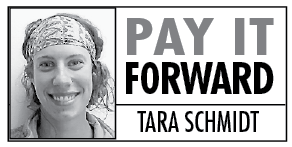“I was waiting for a bus in Philadelphia along with about a dozen others. There was this altercation happening, and all of us there at the bus stop chose to ignore it, including me. I realize looking back on it that collectively, we had created a culture of doing nothing.”
Sue Rennolds told this story during a Green Dot class and it still sticks with me. The familiar feeling of helplessness, hesitancy and mutual discomfort. I’ve been there. It’s called the bystander effect.
According to research on the bystander effect by social scientists John Darley and Bibb Latane, human behavior is often dictated by social cues. Have you ever peered in one direction because you saw a group of people looking that way? Have you ever waited until someone else started leaving the party to also exit?
Other contributing factors to the bystander effect are that the presence of others diffuses the responsibility to act: the more people there, the less one person is likely to step up and do something. The ambiguity of a situation — what if it’s nothing? — causes pause. Or, people simply don’t know what to do.
Many of us are trained to respond in first aid emergencies. In American Red Cross CPR training videos, students are instructed to be specific in their delegation. Point at people. “You, call 9-1-1. You, get the AED.” Not “Someone call 9-1-1.” We’re aware of the steps that need to be taken and we’re prepared to work around the bystander effect.
We can be prepared in a similar way for instances of interpersonal violence like the one Sue described by taking a Green Dot class. Green Dot is a nationwide violence prevention model with a very simple mission: to reduce rates of child abuse, dating and domestic violence, bullying, stalking and sexual assault by educating and empowering bystanders. And, with high rates of these kinds of violence on the Kenai Peninsula, most of us are likely to be a bystander at some point in time.
Tracie Brown, who was trained in Green Dot bystander skills, said: “[It] gave me a way to feel prepared for challenging moments when I may encounter violence in my sphere of influence. The Green Dot Program teaches simple strategies that anyone can use to diffuse or circumvent a potentially violent situation.”
Since Green Dot’s launch last spring, more than 150 Homer residents have participated in Green Dot classes.
We’re learning that reacting to violence is not enough to stop it. You can’t win a softball game simply by preventing the other team from scoring runs. You need offense. To truly make our communities safer, we need proactive actions, measures, policies. We need to have conversations with the people in our lives to think about what our role in ending violence can be.
Here’s my task for you. Think about a situation in which you saw someone harming another person, and you wanted to do something, but chose not to act. Share that experience with someone. Talk about the reasons why you didn’t act. Together, brainstorm things you could have done with those obstacles in mind. If you get stuck, you can always “Ask Dotty” on www.greendothomer.org. You’ll be prepared the next time, and your friend will know, it’s important to you to speak up in situations like the one you discussed together.
“It’s not a drastic change of perspective, but a toolkit that constantly expands with each conversation we have,” said Sierra Frost, who attended a four-hour Green Dot class. “I pose scenarios to the Green Dot group (via Facebook) that occur in my life or that others share with me to be able to problem-solve better. Green Dot enables each individual to act in a way that matches their beliefs and comfort levels.”
Depending on how much time you have, there’s endless ways to get involved. If you haven’t taken a Green Dot class, there are hour-long sessions on Mondays, Aug. 18 and Sept. 22 from 5:30-6:30pm at the Homer Chamber of Commerce. RSVP to rachel@havenhousealaska.org.
Or, you can peruse www.greendothomer.org and get the basics there. You also can request a training for your workplace or group on the website. If you’re familiar with the program, reach out to us. Post your questions to Facebook, or tell us what green dots (proactive or reactive) you’ve done.
You have the freedom to take Green Dot and make it yours. You get to dictate what it looks like in your life, whether it’s a get-to-know-your-neighbor barbecue or educating people in your family about being bystanders who choose to act.
We have the ability to define what kind of community Homer is and will be, whether it contains a culture of doing nothing, or a culture that keeps people safe. Violence is everybody’s problem. And everyone can take part in the solution.
Tara Schmidt is a AmeriCorps VISTA serving South Peninsula Haven House and a Green Dot instructor.



